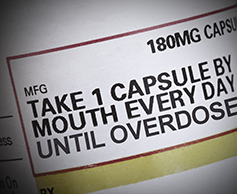People Who Survive an Overdose Still Receive Prescriptions—A Huge Flaw

The prescription drug epidemic of the 21st century has the United States in the throes of a constant, vicious cycle of addiction. In a lot of ways, this seems like a problem that we can’t escape from, no matter what we do. Prescription opioids create great risk in those who take them and are directly responsible for more than forty-thousand of the sixty-four thousand drug overdose deaths that occurred in 2016. Every year, the majority of people who die from drugs and alcohol are people who overdose on opioid pain relievers.
When an opioid addict overdoses, they are usually treated medically and they usually survive the overdose. In actual fact, only about one out of three to four overdoses leads to a death, so the fact that sixty-four thousand thousand people died from overdoses in 2016 means that there were closer to two-hundred thousand overdoses total. One would think that, after such a narrow scrape with death, such individuals would never want to take those drugs again. However, a study done by the Boston University School of Medicine last year indicated that no less than ninety percent of patients who survive an overdose on opioid painkillers will end up later filling a prescription for the very drugs that they overdosed on!
The Boston University School of Medicine report was published in the Annals of Internal Medicine. The study examined insurance claim information and medical information for 3,000 people who overdosed on opioid painkillers in the last 12 years. The vast majority of those patients who did overdose on their prescriptions just ended up going right back on their prescription again, whether their prescribing doctor knew about the recent overdose or not.
Drug Overdoses Now at Epidemic Levels
In 2012, the Centers for Disease Control and Prevention upgraded the threat levels of opioid overdoses in the United States to a full-on Epidemic. In 2017, President Trump labeled the opioid overdose a “National Public Health Emergency.” There is no doubt at this point that our opioid problem is the worst its ever been.

This is a cataclysmic problem. More than twenty-thousand people lost their lives from opioids alone in 2014. The total death toll that year from drugs was closer to forty-seven thousand. In 2015, another thirty thousand died from opiates. In 2016, more than forty-thousand died from opiates. According to the CDC, almost five-hundred thousand Americans have now lost their lives to drugs since the turn of the century.
Changing Prescribing Trends
A major focus going forward must be on changing prescribing trends and reducing the prescriptions written for such potent and dangerous drugs. Doctors need to find a balance in prescribing pain drugs between the risks of prescribing these drugs and the potential, yet extremely limited benefits.
Do painkiller opioids need to be prescribed for as long as they are or in the potency that they are prescribed? No. The problem is, the majority of painkillers are prescribed for physical problems they were not intended to address. The majority of pain patients are patients who suffer from back pain, headaches, and jaw pain. Opioid painkillers are intended to help people who are fresh out of surgery, people with serious, terminal illnesses, and cancer patients. Opioid painkillers belong in hospitals for intensive pain relief, not in the medicine cabinets of American homes.
The first step here is to completely shift the way opioid drug prescribing is done in the United States. We can’t keep using opioid painkillers as a solution for every, little problem that comes along. First of all, they don’t work. Second of all, they cause rampant addiction, dependence, and even death in a significant percentage of those who take them. Furthermore, all of that happens while the pharmaceutical industry profits hundreds of billions of dollars off the backs of enslaved addicts; Americans who are hooked on legal drugs. It has to stop.
Sources:


